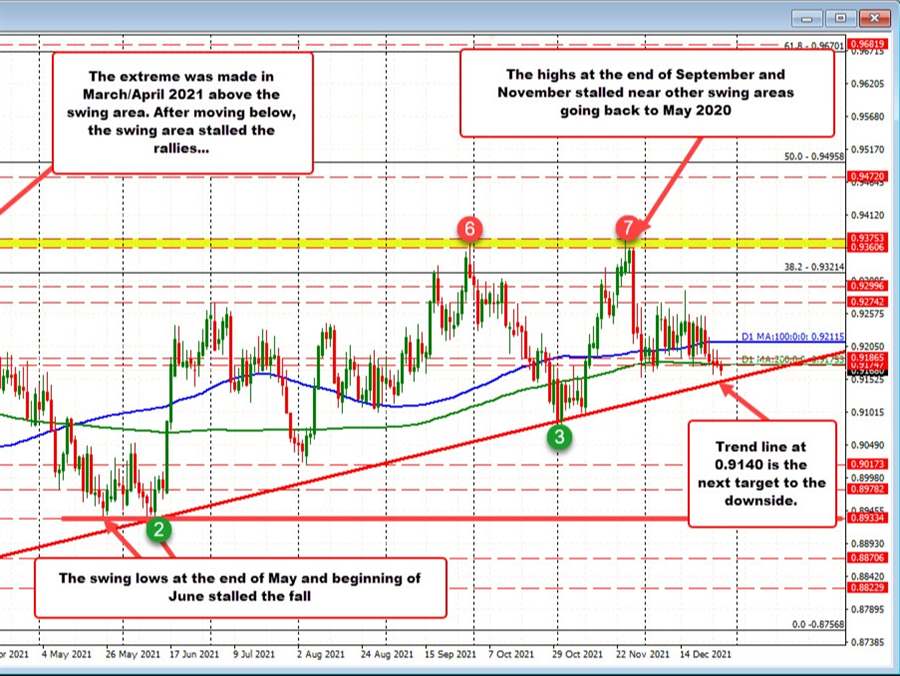
The USDCHF has seen a recovery to the upside in 2021 (flow out of the safety of the CHF and rise of the USD), but the gains have been somewhat limited, and the year is looking to end with a more bearish bias technically on the longer term weekly chart.
For the year, like the EURUSD and the USDJPY, the pair’s USD low extreme was set in the first week of the calendar year. That low was set on January 6th at 0.87568 (the day of the storming of the Capitol by Trump supporters in Washington DC). The low was also the lowest level since January 2015.
The high for the year was set back on April 1, at 0.9472. The low to high trading range was 715 pips. The most recent ranges show:
- 2020 had a range of 1109 pips
- 2019 had a range of only 593 pips
- 2018 had a range of 951 pips
- 2017 had a range of 910 pips
- 2016 had a range of 906 pips
So overall, the volatility was muted relative to recent yearly low to high price ranges. You can see that by visually looking at the weekly chart. The price action is higher but with lots of ups and downs as well.
Since reaching the high on April 1, the pair spent the next 6 of the next 8 weeks moving lower to a swing low of 0.89299 on May 25. A few weeks later on June 9, the price low reached just below that level at 0.89255, but could not go any further. The near double bottom has remained the lowest levels for the rest of the year as the price chopped higher into year end.
The most recent high prices have come in at 0.93676 on September 30, and 0.93729 on November 24. Those highs came within five pips of each other and corresponded with other swing lows and highs going as far back as May 2020 (see red numbered circles on the daily chart below between 0.9360 and 0.9375). Those highs will be a key bullish barometer in 2022.

Technically, there are some key levels on the weekly chart that give the pair a more bearish bias going into the year end.
- The price high for the year stalled ahead of the 50% midpoint of the range since the 2019 high.
- The swing area between 0.9360 and 0.9375 held resistance at the end of September and again in November (see red numbered circles on the daily chart). Staying below the extreme for the year and reestablishing the swing area going back to May 2020, sets a lower ceiling and was more bearish.
- The price is below its 100 week moving average (blue line in the weekly chart above) at 0.92367. The price has traded above and below that moving average over the previous six trading weeks, but so far this week, the price has stayed below the moving average level giving a more bearish bias.
If the buyers are to take more control, getting above those levels (one at a time) would be required starting with the 100 week moving average (which really isn’t that far away but still needs to be broken).
What might also help the pair even if the price does move to the downside into the year end, is if the price can remain above the rising trend line reaching back to the January low.
In 2021, the trend line was set off the June low, and then was tested in November. That trendline currently cuts across at 0.9140 (and moving high – see weekly and daily charts). Holding above that trendline would give the buyers some hope for another bounce to the upside.
Conversely, if that trendline is broken, the bearish bias would increase and have traders looking toward the swing low at 0.9081 and a swing area between 0.8978 and 0.9017 as the next targets. Move below those levels and the sellers become even more in control with 0.8930, 0.8870, 0.8822 and the low for the year and 0.87568 as targets.
Move above the 100 week moving average, and traders will look toward the 38.2% retracement of the move down from the 2019 high at 0.93214, followed by the key swing area between 0.9360 and 0.9375 (red numbered circle). Above that and the high for 2021 at 0.9472 and the 50% midpoint at 0.94958 and the 200 week moving average at 0.9559 would all become upside targets.

 This “NEW CONCEPT” Trading Strategy Prints Money!… (INSANE Results!)
This “NEW CONCEPT” Trading Strategy Prints Money!… (INSANE Results!)
